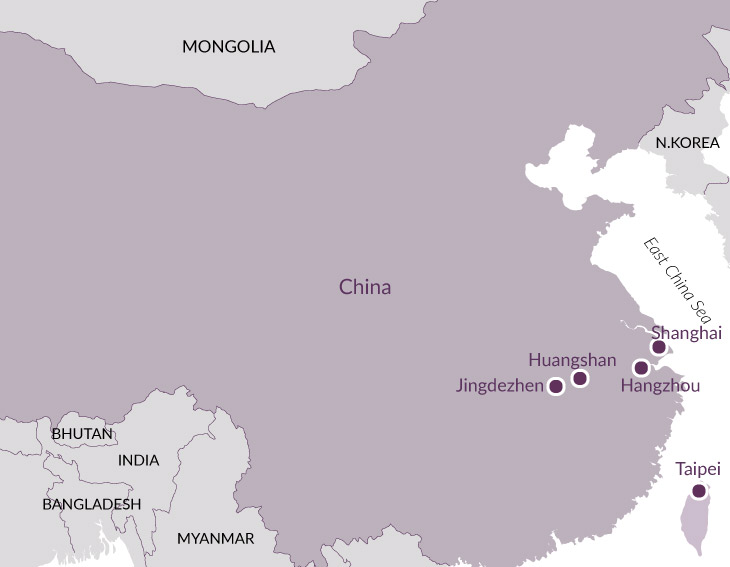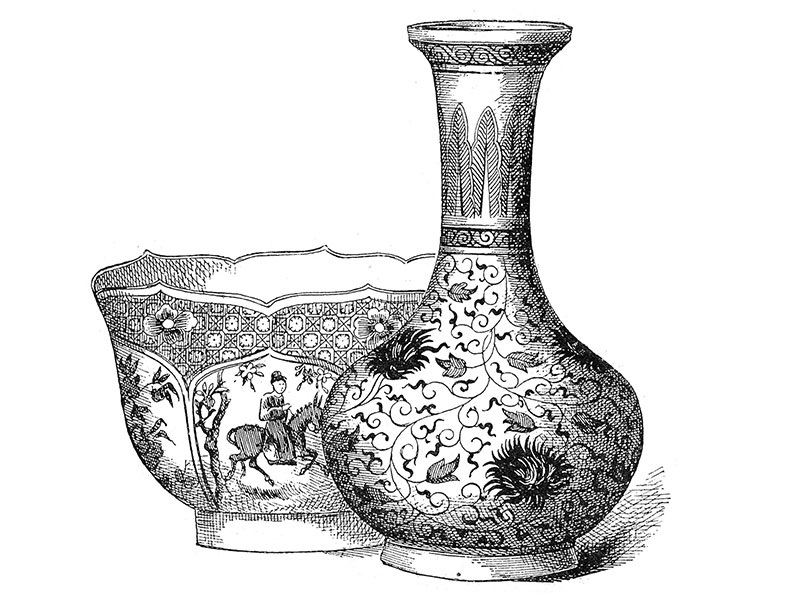Overview
Chinese porcelain has been called the first globally traded luxury. For centuries its magical whiteness and translucency, its vibrant blues and later its gorgeous colour painting held princes and aesthetes in its spell. It was not until a whole millennium after its emergence in China that the secret of its manufacture was discovered in Europe in the early eighteenth century.
In AD 1004 the reigning Song emperor conferred his name upon the porcelain-making city of Chang-Nan, later known as Jingdezhen. It supplied the imperial household in Beijing, transporting its wares along the Yangtze and the Grand Canal, while other river and laborious overland routes were established to fulfil orders from Persia and later from foreign merchants in Java, Macao and Shanghai. To this day Jingdezhen continues as a major centre for ceramic production with a happy co-existence of ancient traditions and modern processes.
The journey from Jingdezhen to Hangzhou passes the dramatic Mt. Huangshan and ancient villages nestling in landscapes first revealed to Europeans in depictions on vases and tea services. The Southern Song capital of Hangzhou is the southern terminus of China’s – and one of the world’s – greatest civil engineering achievements, the Grand Canal. Begun in ad 612 it ran north-west to Beijing via Luoyang.
Across the straits in Taipei, capital of Taiwan, the fabled imperial treasures are on display at the National Palace Museum. Amassed over centuries by the emperor-collectors of the Yuan, Ming and Qing dynasties, it is the world’s finest collection of Chinese art. In 1949, as the war between Nationalist and Communist forces neared its conclusion, Chiang Kai-shek ordered that the collection be shipped to Taiwan to prevent the treasure falling into the hands of the victorious Communists. There it remains, a collection so large that the NPM rotates 3000 of its exhibits every three months.
For the devotee of Chinese porcelain this tour provides a unique opportunity to study some of the finest examples in the context of its manufacture, trade, cultural framework and proximate landscapes. For the merely interested, it is likely to bequeath a lifelong capacity to delight in one of the world’s most intensely beautiful artforms.
Day 1
Shanghai. The tour begins with lunch at the hotel (flights from London are not included – see Practicalities). A relatively young city by Chinese standards, Shanghai is now the nation’s largest and most dynamic. There is an afternoon walk along the Bund, the imposing and well preserved riverside stretch of Art Deco and Neoclassical buildings from the period when Shanghai was one of the world’s greatest financial centres. First of two nights in Shanghai.
Day 2
Shanghai. The world-class Shanghai Museum is home to an extensive collection of masterpieces of Chinese arts from the Neolithic period to the Qing dynasty. The fabulous ceramics galleries offer a superb narrative foundation for the days ahead. There is time for independent exploration of the museum’s superb bronze, painting, jade and furniture collections. The 16th-century Yu Garden is visited in the afternoon, an excellent example of classical garden design.
Day 3
Jingdezhen. Fly (Shenzhen Airlines) to Jingdezhen. In the afternoon visit the studios of working potters Felicity Aylieff and Takeshi Yasuda (by special arrangement). There is time to explore Tao Xi Chuan, a recently restored former ceramic production site. Overnight Jingdezhen.
Days 4 & 5
Jingdezhen. Two days are spent in and around Jingdezhen. In these hills around lay the once secret resource of kaolin clay and china stone, which, when processed in the water-powered mills, formed the potters’ basic material. Traditional manufacture is demonstrated at the Ancient Kiln Complex. The new, impressive China Ceramics Museum excellently displays pottery and porcelain from various periods and kiln sites.
Day 6
Jingdezhen to Huangshan. In the morning, visit a ceramic research institute (subject to special permission) before driving to Huangshan (c. 2½ hours) for two nights.
Day 7
Huangshan. Conditions permitting, there is a full-day excursion by coach and cable car to the magnificent peaks of Mt. Huangshan (Yellow Mountain). Jutting granite and ancient pines, often shrouded by clouds, have long inspired Chinese art and literature and consequently the world’s imaginings of oriental landscape. (If Mt. Huangshan cannot be visited, there will be alternative visits to traditional villages in the foothills.)
Day 8
Huangshan to Hangzhou. Drive through the southern tip of Anhui province, dominated by the spectacular mountain scenery, stopping for lunch in a traditional village in Shexian County (formerly Huizhou). Reach Hangzhou in time for supper. First of two nights in Hangzhou.
Day 9
Hangzhou. The scenic tranquillity of the city’s West Lake has been immortalised by countless poets and painters over the centuries. See the excavated imperial dragon-kiln site of Guan wares, one of China’s most treasured wares. Visit the Grand Canal Museum before crossing over the historic waterway into the neighbouring traditional village area.
Day 10
Hangzhou to Taipei. Fly at c. 9.30am (Air China) from Hangzhou to Taipei. After lunch visit the Confucius Temple, the only such temple in Taiwan with southern Fujian-style ceramic adornments. First of two nights in Taipei.
Day 11
Taipei. Spend a full day at the National Palace Museum for a detailed study of its comprehensive ceramics collection. There is also time for independent exploration of the other, equally impressive, collections in the museum.
Day 12
Taipei. The tour ends after breakfast. There is a transfer to the airport in time for the flight at 10.50am from Taipei to Hong Kong, arriving at c. 12.30pm (c. 1 ½ hours).
Price, per person
Two sharing: £4,790. Single occupancy: £5,460.
Included
Domestic air travel (economy class) with Shenzhen Airlines: Shanghai to Jingdezhen (Airbus A320), Air China: Hangzhou to Taipei (Boeing 737-800); transport by air-conditioned coach; accommodation as described below; breakfasts, 11 lunches and 7 dinners with wine or beer or soft drinks, water, coffee, tea; all admission charges to museums; all tips for waiters, drivers and guides; the services of the lecturer, tour manager and local guides.
Flights
Flights from London to Shanghai and Taipei to London, via Hong Kong, are not included in the price of the tour. We will send the recommended flight options (that will be accompanied by our lecturer and/or tour manager) when they are available to book and ask that you make your own flight reservation and inform us of the details. The cost of a World Traveller (economy) seat at the time of going to press is c. £800 and will be available to book towards the beginning of June 2017.
Visas
Required for most foreign nationals, and not included in the tour price.
Accommodation
Yangtze Boutique Hotel, Shanghai: 4-star, Art Deco hotel ideally situated close to the Shanghai Museum. Taoxichuan Traders Hotel, Jingdezhen: 4-star hotel opened in 2016 in one of the very recently and sensitively restored buildings on a former ceramic production site. Crowne Plaza, Huangshan: a large international 4-star hotel on the outside of the city. Sofitel West Lake Hotel, Hangzhou: 4-star hotel located on the east side of the West Lake (rooms do not have lake views). Landis Hotel, Taipei: centrally located, 4-star, Art Deco-style hotel.
How strenuous?
A good level of fitness is essential. Unless you enjoy entirely unimpaired mobility, cope with everyday walking and stair-climbing without difficulty and are reliably sure-footed, this tour is not for you. Uneven ground and irregular paving are standard and the tour involves a lot of standing around in museums. There are two long coach journeys during which facilities are limited and may be of poor quality. Average distance by coach per day: 49 miles
Are you fit enough to join the tour?
Group size
Between 10 and 22 participants.
Travel advice
Before booking, please refer to the FCDO website to ensure you are happy with the travel advice for the destination(s) you are visiting.

'The lecturer was dynamic and entertaining throughout and left us with lasting memories of a tour which was both exciting and educational.'
'We really enjoyed the tour. It was a unique experience and we now know so much more about Chinese porcelain and its context.'
